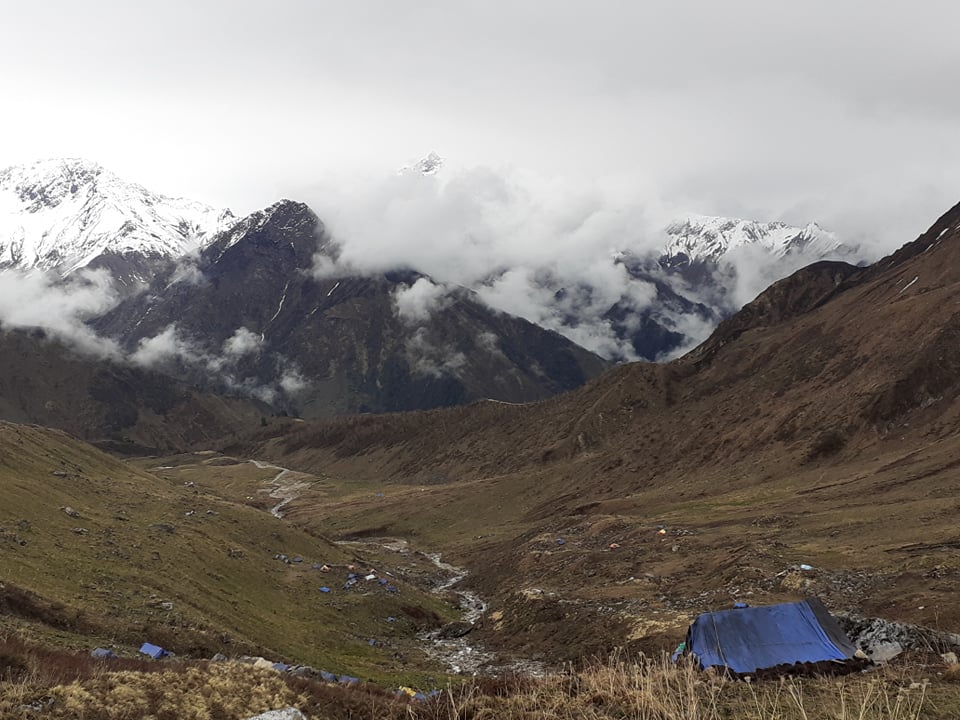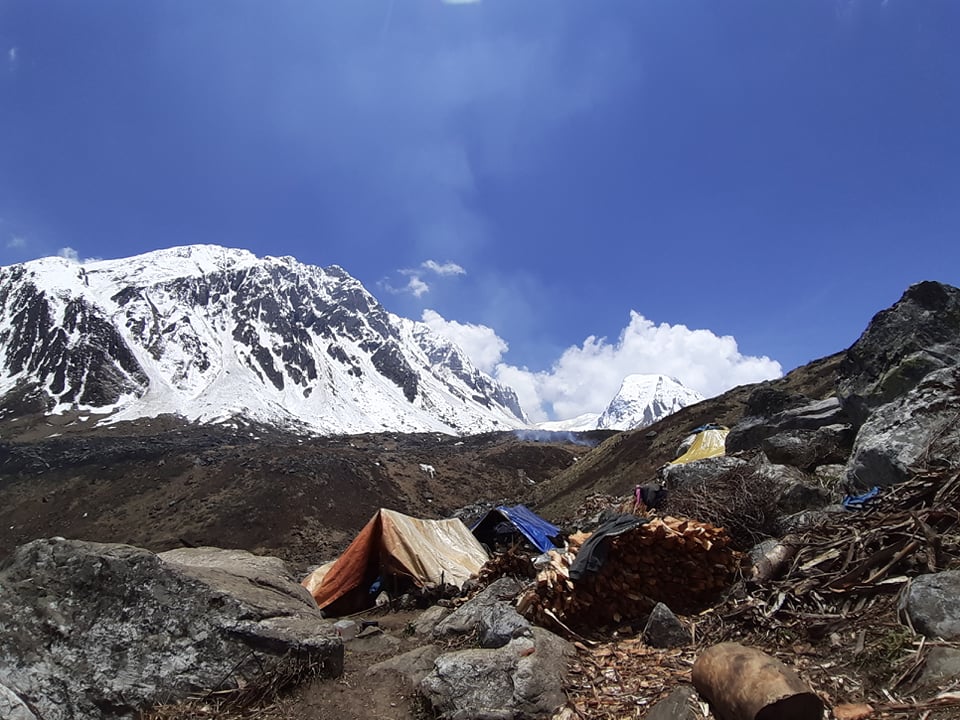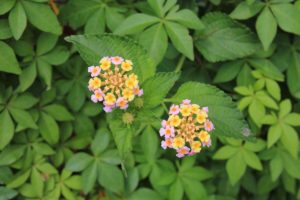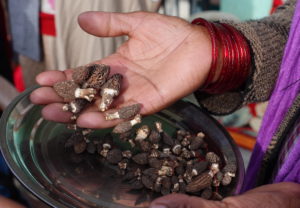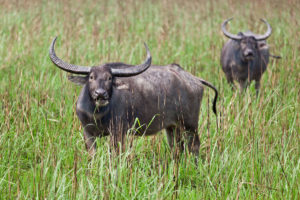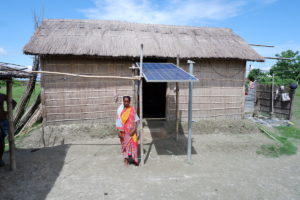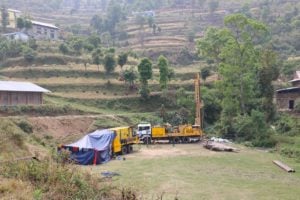Every year in mid-May, as the snow begins to melt in the Himalayas, tens of thousands of villagers from the northern districts of Nepal climb to the alpine meadows. Here, they crawl along the mountainsides, searching painstakingly for tiny, dark brown protrusions from the soil. These stalks are not plants, but a rare fungus, locally known as yarsagumba, meaning ‘summer grass, winter worm’.
Ophiocordyceps sinensis, also known as caterpillar fungus, is a type of parasitic fungus that infects caterpillars underground. Over months, it paralyses and eventually consumes its host, before growing upwards, out of the caterpillar’s head, to protrude above ground and spore. Used in traditional medicine, demand for the fungus has skyrocketed in the past 20 years – and so has the price.
In autumn, caterpillars become infected with fungal spores. Over the winter the fungus spreads and kills its host. In spring, the fungus ruptures out of the caterpillar’s head and above the soil, where it can be harvested for the next two to three months.
The cordyceps needs to be extracted fully intact because even the slightest damage reduces its value significantly. Harvesters dig a hole, rather than picking the fungus out of the ground directly, but usually leave the hole unfilled, disturbing the fragile alpine habitat.
Thefungus is used in traditional Tibetan and Chinese medicine, where it is believed to treat a range of conditions and boost energy and stamina. Sources of high demand for cordyceps from Nepal include Korea, Taiwan, Hong Kong, Mynamar, Thailand, Singapore and Japan.
Outside the Himalayas and Tibetan Plateau cordyceps is also referred to as ‘Himalayan Viagra’ and ‘Himalayan Gold’.
In Nepal, this lucrative fungus has become the primary source of income for many families. They tend to be smallholder farmers in rural communities with limited alternative livelihood opportunities. In some districts, the food families grow may sustain them for as little as five months; for the rest of the year, they depend on selling cordyceps to survive. In my research, which is yet to be published, I found that cordyceps contributes up to 87% of the household income of harvesters in districts like Bajhang in northwestern Nepal.
Families therefore work together to gather as many as cordyceps as possible during the harvesting season between May and August.
Similarly, in other places where cordyceps is found, such as the Tibetan Plateau and alpine pasturelands of Bhutan and India, its harvest plays a crucial role in communities’ livelihoods. However, as a result of high demand and overextraction, cordycepsis declining and is listed as vulnerable on the IUCN Red List of Threatened Species. In a vicious circle, demand intensifies as it becomes more scarce.
Cordyceps can sell for as much as USD 40,000-50,000 per kilogram,and in 2012 reached USD 110,000 per kg in Beijing
In 2022, the Nepali Times reported that harvesters were paid 300-350 Nepali rupees (USD 2.3-2.6) per piece (weighing a fraction of a gram), but could get up to NPR 1,000 (USD 7.6) if the fungus was large and golden yellow.
In the late 1980s, cordyceps had little monetary value and were exchanged for items like cigarettes and noodles, which were scarce in villages. By 2001, harvesters were getting NPR 20-25 per piece and by 2011 NPR 200-600, an increase of as much as 2,300%.
Left: A freshly picked cordycepsinthe rangeland of Bajhang in May 2021. Its colour means it would fetch a higher price. (Image: Suman Rawal)
Cordyceps harvest continues despite lockdown-led ban
In 2020, lockdowns to control the spread of Covid-19 confined cordyceps-harvestingfamilies to their homes. District authorities across Nepal’s mountain districts, including Dolpa, Mustang, Mugu and Bajhang, banned the harvest of the fungus for the 2020 season.
Cordyceps is found in 26 northern districts of Nepal, with commercial harvesting taking place in 13. Out of these, Bajhang, Darchula, Dolpa, Jumla and Manang constitute up to 95% of the total commercial trade.
To find out about the impact of the 2020 ban, in 2021 I conducted a study in Bajhang. I interviewed 100 people in the food-insecure district. The findings revealed that despite the ban, over 72% of people interviewed gathered cordyceps, driven by a desperate need to feed their families. “We have no choice but to harvest yarsagumba to survive, farming alone cannot sustain us,” one interviewee told me. Indeed, it was reported that hundreds of people gathered illegally in the rangelands.
“In 2020, even the collection ban could not hold back the harvesters from cordyceps and for the harvesting season of 2021 and 2022 it was just business as usual or even worse with an increased number of harvesters,” a former ward president told me. Harvesting was not restricted in 2021 and 2022.
Rampant harvesting puts pressure on threatened fungus
There is a multitude of threats to cordyceps, including overharvesting and premature harvesting. The prolonged camping of harvesters in fragile alpine regions degrades habitat, as harvesters cut trees for fuel and leave rubbish behind. Trampling on soil and vegetation may affect the microhabitat of the rangeland, impacting fungal spores as well as other species.
Increasing nitrogen pollution in the rangelands may also adversely impact the fungus, by changing its habitat. The situation is further aggravated by the impacts of climate change, as alterations in temperature and rainfall patterns affect how cordyceps form, and their insect hosts.
In the past 20 years it has become increasingly difficult for harvesters to collect the same quantity of cordyceps as in the past. To put this into perspective, on average people spent 17 days in 2006 harvesting cordyceps in Dolpa district. My research found this was 70 days in 2019 in Bajhang district. This could be due to both the declining numbers of cordyceps and the increased number of harvesters in recent years.
“The situation is becoming worse due to the declining number of cordyceps in its habitat and the increasing competition among harvesters,” the former ward president told me.
11
Number of Ophiocordyceps species that have been recorded in Nepal. Globally there are more than 500 species.
Fewer harvesters may benefit communities as well as reduce pressure on the rangeland. My 2021 study found that those who harvested cordyceps illegally in 2020 spent on average 45 days in the rangeland, as they were able to collect enough in less time due to there being fewer harvesters overall. A person’s average daily harvest increased from 0.94 grams in previous seasons to 2.01 grams in 2020.
“Despite the fear of being caught, we went to the rangelands during the ban and found more yarsagumba per day than before due to less competition,” said a harvester I interviewed.
Sustainable harvesting framework needed
The ineffectiveness of the Covid-19 ban shows that other initiatives are needed to make harvesting sustainable.
Cordycepsis harvested in large rangelands called patans, which have open borders. The harsh terrain, coupled with the government’s limited resources, makes monitoring and regulating the harvesting very difficult. Harvesters do have to buy permits, and some districts have set quotas and harvesting days, although the rules and their enforcement vary.
The Covid-19 lockdown highlighted the extent to which communities are dependent on cordyceps
Events like the Covid-19 lockdown highlight the extent to which communities are dependent on cordycepsand how its decline could be disastrous. To balance the needs of harvesters and to protect the health of the habitat, a national-level framework for harvesting cordyceps sustainably is needed.
Such a framework requires:
- Harvesting guidelines. This would include setting quotas on the amount that can be harvested per square kilometre and promoting techniques that prevent damage to the ecosystem. Harvesters would fill the holes dug to extract cordyceps, manage their waste and use alternative fuel sources when on rangelands.
- Managing harvesters. Prioritise households in poverty with access to rangelands; overall reduce the number of harvesters; and carefully monitor the harvesting period. Harvesters should be at least 18 years old and possess identification to enter the collection area.
- Reducing poverty. Provide people in poverty with financial institutions and soft loans. Currently wealthier households in villages charge those who are less well-off loans at higher interest rates. Helping people escape debt traps will relieve some of the pressure on poor families to extract cordyceps at unsustainable levels.
- Diversifying livelihoods. Explore other non-timber forest products and other sectors to reduce dependence on cordyceps.
- Research and monitoring to understand the health of the rangeland ecosystem. This should include a study to determine the carrying capacity of the habitat and identify the quantity of cordyceps that can be extracted sustainably.


